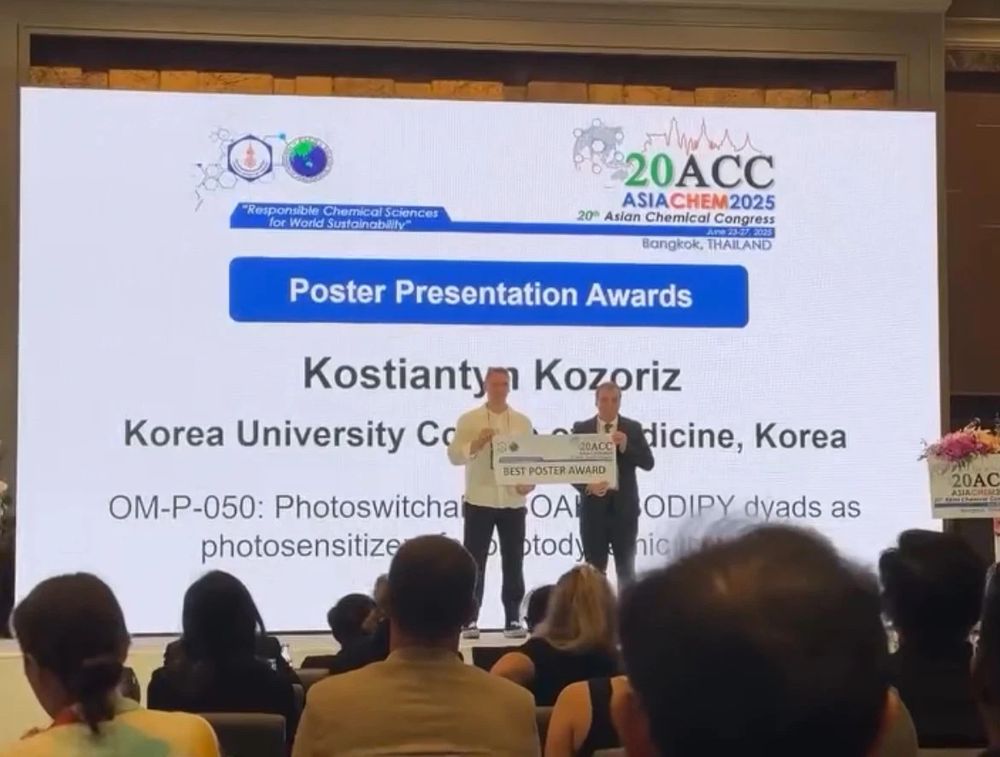
It is really happy news that my graduate student, Kostiantyn, from Korea University College of Medicine received the best POSTER award from 20th Asian Chemical Congress at Bangkok, Thailand. Huge congrats!
#chembio #KoreaUniversityCollegeOfMedicine
#AsianChemicalCongress #Bangkok
26.06.2025 12:30 — 👍 1 🔁 0 💬 0 📌 0
My graduate student Kostia and I wrote a comprehensive tutorial review article for researchers who grt interested in this technique, and just published in Chem.Soc.Rev.
19.05.2025 09:38 — 👍 1 🔁 0 💬 1 📌 0
Do you have bioactive compounds/drug molecules and want to unveil the mode of action? Chemoproteomic profiling is a promising solution to reveal the interaction partners in the cells, so to get a sense of how it works.
19.05.2025 09:37 — 👍 2 🔁 1 💬 1 📌 0
 15.04.2025 07:00 — 👍 0 🔁 0 💬 0 📌 0
15.04.2025 07:00 — 👍 0 🔁 0 💬 0 📌 0
⭐ Prof. Randy Seeley (University of Michigan, USA)
⭐ Prof. Hiroaki Suga (University of Tokyo, Japan)
⭐ Prof. Sunghoon Kim (Yonsei University, Korea)
15.04.2025 06:59 — 👍 0 🔁 0 💬 1 📌 0
I’m thrilled to announce the launch of the Drug Target Discovery Institute on April 28 at Korea University College of Medicine!
Check out the opening symposium poster & join us for an inspiring symposium featuring three world-renowned keynote speakers:
15.04.2025 06:59 — 👍 1 🔁 1 💬 1 📌 0
We make a DC50 value table for various AIE and organic fluorophores. If you are in AIE chemosensing, this table can be useful reference data for your design.
#KoreaUnivrtsityCollegeOfMedicine #chemosensor #AIE #DC50
19.01.2025 07:16 — 👍 0 🔁 0 💬 0 📌 0
https://onlinelibrary.wiley.com/doi/10.1002/bkcs.12933
Dis-/aggregation-dependent chemosensing is well-studied, but quantitative insights into supramolecular aggregation remain scarce. Our study introduces a straightforward approach: DC₅₀ plotted against solvent polarity parameters, offering valuable insights for chemosensor design. #AIE
t.co/nU7axereRA
19.01.2025 07:15 — 👍 0 🔁 0 💬 1 📌 0

Aptamer and N-Degron Ensemble (AptaGron) as a Target Protein Degradation Strategy
Target protein degradation (TPD) is a promising strategy for catalytic downregulation of target proteins through various cellular proteolytic pathways. Despite numerous reports on novel TPD mechanisms, the discovery of target-specific ligands remains a major challenge. Unlike small-molecule ligands, aptamers offer significant advantages, owing to their SELEX-based systematic screening method. To fully utilize aptamers for TPD, we designed an aptamer and N-degron ensemble system (AptaGron) that circumvents the need for synthetic conjugations between aptamers and proteolysis-recruiting units. In our AptaGron system, a peptide nucleic acid containing an N-degron peptide and a sequence complementary to the aptamer was designed. Using this system, we successfully degraded three target proteins, tau, nucleolin, and eukaryotic initiation factor 4E (eIF4E), which lack specific small-molecule ligands. Our results highlight the potential of the AptaGron approach as a robust platform for targeted protein degradation.
If you are interested in TPD tech but worried about synthesis of the compound, you can still design your own TPD agent using Aptamer and N-Degron Ensemble (AptaGron) platform. Check out our strategy from our latest study.
pubs.acs.org/doi/10.1021/...
#KoreaUniversity #PROTAC #TPD
22.12.2024 04:23 — 👍 3 🔁 1 💬 0 📌 0



 15.04.2025 07:00 — 👍 0 🔁 0 💬 0 📌 0
15.04.2025 07:00 — 👍 0 🔁 0 💬 0 📌 0





